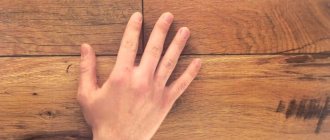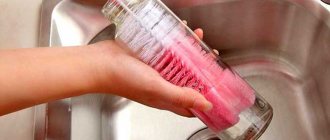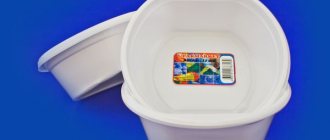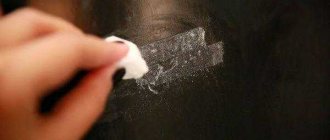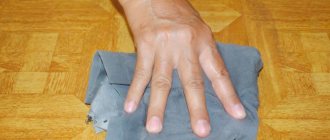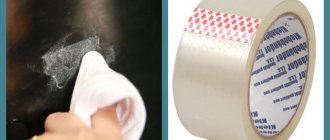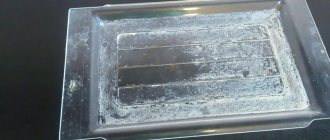Renovation work brings joy after its completion, when the room becomes more beautiful. But before you can enjoy your new surroundings, you need to do some cleaning. After all, after using different building materials, stains often remain on the surface. The use of liquid nails is popular, but even careful practice will not completely avoid marks from the solution. Therefore, you should know how to efficiently remove the consequences of repairs from different types of foundations. Details on how to wipe off liquid nails will be discussed in the article.
How to remove liquid nails at home
Liquid nails are an adhesive solution that can reliably and firmly hold different materials together. They are chosen when the use of screws and self-tapping screws is not desirable. For example, for working with plastic parts that will not withstand such installation. This is also an option to carry out repairs faster and without unnecessary noise.
The products are used for the installation of tiles, laminate, linoleum, metal products, plastic and other materials.
Due to its quick-drying properties, it is convenient to use the solution, but this can cause problems in the future. After all, it is difficult to remove a frozen layer of nails; you need to figure out how to dissolve liquid nails so as not to cause damage to the surface. On different bases, the layer will be removed in different ways.
Liquid nails are an adhesive solution that can reliably and firmly hold different materials together.
Removal from clothes and hands
After finishing work, you will need to clean your hands, which can be helped by the usual thorough washing with soap and water or cleaning with a solvent. There is no point in wiping your hands with anything.
Gently dampen a cotton swab with nail polish remover and wipe each spot. Do not pour a large volume of solvent onto your skin as this may cause irritation. At the end of the procedure, soak your hands and skin that came into contact with liquid nails well with an emollient cream.
Clothes are cleaned with a special remover for a specific type of liquid nails. This glue remover is sold in stores. You should definitely pay attention to whether it is intended for water-based or organic glue.
Source
In construction and repair work, adhesives are often used to securely fix various structures and materials. After completing the work, the surfaces of all objects in the room must be put in order - remove drops of glue, traces of paint, stains after plastering. When carrying out general cleaning after repairs, you need to know how to wipe off liquid nails - a high-strength composition that is used to glue products of homogeneous and heterogeneous structure. Dried glue is difficult to remove, but using special products will make the job easier.
Determination of adhesive composition
Liquid mortar for bonding materials can be produced with different bases. To understand how to dilute a layer, you need to distinguish between the characteristics of the types, for example, there are types with a solvent base or with water. Compositions are selected based on operating conditions.
Liquid mortar for bonding materials can be produced with different bases.
Water based
They are distinguished by their environmentally friendly properties due to the absence of toxic substances. There will be no strong odor during operation, but the reliability and strength of the base connection is not as high as that of the next type. The drying time is slower and water evaporates. A suitable option for working with light panels and other light objects.
Not selected if it is necessary to glue large, heavy items. The solution is a little easier to clean up than the diluent-based type.
A suitable option for working with light panels and other light objects.
Solvent based
The presence of solvents in the composition makes it possible to obtain a strong adhesion that can reliably hold even heavy objects for a long time with wood, tiles, massive mirrors, etc.
However, they emit a pungent odor and the presence of toxic elements requires the use of protective equipment when working. It will be difficult to remove such a layer from a bathroom wall or other surface.
You should study the instructions from the manufacturer before purchasing the product in order to immediately understand what additional substances you should have on hand.
The presence of solvents in the composition makes it possible to obtain a strong adhesion that can reliably hold even heavy objects for a long time.
How to remove rubber glue?
Excess glue before it has completely dried can be removed with the same gasoline. Already dried glue can be dissolved with solvent R-4.
Interesting materials:
How to get a student visa to Korea? How to get a student visa to the USA? How to get subsidies for housing and communal services? How to get subsidies for light? How to get an individual entrepreneur subsidy if you don’t have a current account? How to get a subsidy for opening an individual entrepreneur in Belarus? How to get a court order? How to get the Chaos Chronicles super titan? How to get light beige color? How to obtain an Inn certificate after changing your last name?
What tools and materials will be needed
Before you start looking for an option to wash off liquid nails from the surface, you need to read the instructions on the packaging of the product; the type of solution is important. Acrylic types are easier to clean than the neoprene version. Manufacturers usually indicate the liquid nail solvent that can be used.
Often, professionals advise immediately purchasing liquid nails and a special remover for them. But this technique involves aggressive action, so some materials may be damaged. It is necessary to conduct a reaction test in an inconspicuous area.
Most solution residues can be wiped off mechanically. You will need to prepare the following tools:
- Putty knife;
- Metal scraper;
- Sharp knife;
- Thin reliable wire;
- Fishing line.
If you decided to remove the layer using temperature, then a hair dryer is used for the hot method, and a freezer for the cold method.
Rinsing agents release toxicity, so you need to protect yourself. A respirator, protective gloves and goggles are put on, and the room is provided with high-quality ventilation.
Rinsing agents release toxicity, so you need to protect yourself.
Special cases
To remove liquid nails from plastic, try placing a drop of remover on a small amount of building material or in an inconspicuous area. If there are no marks left on the PVC and the material has not changed color, you can safely use a remover to remove the glue.
It is easier to remove the defect from the tile. The tile will not be damaged during removal, as it is a durable material protected from mechanical damage. The exception is tiles with a glossy surface. It scratches easily; when working, strong mechanical influences should be avoided.
When removing wallpaper, choose a solvent that is suitable for this material. Wet a rag with it and apply it to the mixture until everything is absorbed into the fabric. There is no need to rub, as this will damage the texture of the wallpaper.
Leather surfaces are rubbed with oil and Vaseline. This process is long, but the result is worth it.
Stains are easily removed from metal surfaces by exposure to temperature changes.
Procedure if the stain is fresh
Fresh stains are easier to clean than old stains. But special substances can be used only after testing the reaction on a small hidden area of the base. You can use the following work recommendations:
- The solution can be washed off your hands with laundry soap and warm water;
- You can remove traces from furniture with a leather surface after treating the area with baby cream or vegetable oil;
- You can remove layers from clothing by soaking a cotton swab in acetone if the fabric can withstand such exposure;
- Plastic bases are treated with greasy substances.
If the products are unable to completely remove the stain, then resort to mechanical tools, working carefully so as not to touch the base. Solvent-based liquid nails cannot be removed from fabric and leather. Removers are harmful to these materials, so before work you should cover the items with film.
The solution can be washed off your hands with laundry soap and warm water.
Aggressive cleansers
Chemicals can damage the plastic material itself, but this is an effective method for removing superglue from plastic quickly. Before using such products, you should check the reaction of the base to the substance in an inconspicuous area. In any case, act carefully.
Before using such products, you should check the reaction of the base to the substance in an inconspicuous area.
Dimexide
Dimexide effectively removes the adhesive layer from the base, but due to the nature of the plastic, it is necessary to monitor the exposure time. A rag soaked in dimexide can only be applied to the stain for 120 seconds, otherwise the plastic will begin to deteriorate. After impregnation, removing the glue will not be difficult; you just need to wipe the surface with a dry cloth.
Dimexide effectively removes the adhesive layer from the base, but due to the nature of the plastic, it is necessary to monitor the exposure time.
Nail polish remover, acetone
You can use these liquids at home. However, you should not work on a small area of plastic without testing. If the test is successful, then the entire area is covered with acetone, and after 30 minutes you can wipe off the remaining glue.
You should not work on a small area of plastic without testing.
Anticlean
Manufacturers immediately created a means to remove superglue. The substance is more effective; you should purchase the option for the glue you are using.
Wipe the stain with the liquid, wait the required time for the reaction specified in the instructions, and remove the layer with a rag.
The substance is more effective; you should purchase the option for the glue you are using.
Petrol
You will need purified gasoline, it helps to wipe off new traces of glue. Use a damp cloth to wipe off the adhesive layer. You need to wipe with force to completely remove excess superglue. A substance with protection for hands and respiratory tract is used.
You will need purified gasoline, it helps to wipe off new traces of glue.
How to remove dried liquid nails
When traces of liquid nails were discovered late, or it was not possible to promptly clean them, the process becomes more complicated. It is important to follow the technology of working with substances in order to obtain high-quality results.
When traces of liquid nails were discovered late, or it was not possible to promptly clean them, the process becomes more complicated.
Removing stains from skin and clothes
When working, if you are not wearing protective clothing, liquid nails may appear on your skin. Then first try washing your hands in warm water and soap. If this does not help, then rub the skin with oily creams, followed by a scrub.
Removing stains from fabric surfaces is difficult. It is possible to use white spirit, acetone, when the layer dissolves, the product is washed in the usual way. Neoprene compounds penetrate deeply into textiles, making cleaning difficult. Special substances can damage the material. You can use oil dissolution; a mechanical method is also used, but the stain is removed in small pieces.
Rub the skin with oily creams, followed by a scrub.
Cleaning plastic
The plastic surface is easier to clean than textiles. But some types of plastic are sensitive to solvents, so they work carefully. You can replace special substances with turpentine, petroleum jelly, oil. Nail polish remover containing acetone is suitable.
Dimexide, which is sold in pharmacies, copes well with the task.
To avoid this problem, consider the following tips:
- The base is covered in advance with film or newspapers;
- It is advisable to immediately remove a stain with a dry cloth when a stain appears, then wash the area with soap;
- Work quickly, without waiting for the layer to dry;
- When removing a fresh mark, do not rub so that it does not spread further across the surface.
Dimexide, which is sold in pharmacies, copes well with the task.
How to clean tiles and tiles
It is easier to clean tiles mechanically. Use a scraper, wire or fishing line. The stain should be pierced, and then by rotating the layer will move away from the tile base until everything is removed.
You can also use thinners for liquid nails to soften the layer, which can then be easily picked up with a sharp tool.
It is easier to clean tiles mechanically.
Features of wallpaper cleaning
When various objects are glued to the surface next to the wallpaper, drops of liquid nails may end up on their base. The cleaning process must be carried out with the utmost care, otherwise the material will suffer greatly.
A solution remover is used, a piece of fabric is soaked in the product, and the material is applied to the stain so that the layer is gradually removed. The solution should be gradually removed; it is transparent, so no color should appear on the fabric; if this happens, then the paint has already come off the wallpaper.
The cleaning process must be carried out with the utmost care, otherwise the material will suffer greatly.
How to wash?
From the skin
When working with super glue, it often gets on the skin of your hands. If the adhesive gets on your skin, you can’t just get rid of it; you can’t remove it with soapy water. There are three ways to remove the super-substance from the skin of your hands.
For this, as a rule, they use:
- acetone: rub the contaminated area well, and then wash your hands with soap;
- pumice stone: steam your hands and then gently rub the area with pumice stone;
- table salt: wet your hands and pour a large spoonful of salt into your palms, rubbing it until the dirt comes off.
These methods can seriously damage the skin of your hands; after manipulation, you need to apply lotion or hand cream to your skin.
From metal
It is very difficult to remove the super-substance from metal. You can try to scrub the metal surface using acetone or another solvent containing volatile substances, but they do not have time to adhere to the material.
To completely get rid of dirt, apply solvent or acetone to a cotton pad or thick cotton cloth, apply it to the stained area, and stick tape on top. As a result, an airtight environment is created, the adhesive inside will heat up and its remains can be easily removed after removing the tape.
From linoleum
Super glue often ends up on linoleum. To remove it, you should resort to chemical solvents. To clean the surface, choose “Super Moment Anti-Glue”, “Anti-Glue” or “Contact”. When they are applied to a surface, the glue begins to dissolve and turn into a rubber-like substance that is easily removed.
If you don’t have the time or opportunity to run to the store, gasoline is used to remove glue from linoleum. If the stain is already old, you need to wait a few minutes until the glue begins to dissolve. Residues are removed with dry wipes. Sometimes it cannot be removed the first time, then the procedure should be repeated.
When working with gasoline, you should follow safety precautions, as the substance is flammable. There should be no children in the room while working. After working with gasoline, the surface is washed with water.
When buying linoleum, you should read the instructions and find out what products are suitable for its surface. If you have a small piece of linoleum, you can do a test test on it: spread it with glue, and then try to remove it using different means. To clean linoleum, you can use gasoline or ammonia. Do not use acetone for cleaning: it can damage the surface.
From plastic
Very often the question arises of how to remove traces of glue from plastic surfaces. When working with this product, you should be very careful and try to immediately remove drops of glue from the plastic with a regular cloth. After removing the stain, wash the surface with dishwashing detergent.
Plastic does not tolerate temperature changes well, and can also be damaged when using certain chemical solvents, so do not use acetone or gasoline for plastic surfaces.
If the glue on the plastic surface has already dried, you can try to cut it off very carefully. You can also use Dimethyl Sulfoxide to remove adhesive from plastic.
You can buy it at any pharmacy
You can buy it at any pharmacy
You can also use Dimethyl Sulfoxide to remove adhesive from plastic. You can buy it at any pharmacy.
From glass
As with any other surface, it is always easier to remove fresh dirt from glass: just wipe it with a cloth.
For glue that has dried on the base, use:
- cleaner: it is applied to the glass, after a few minutes it is removed with a knife;
- white spirit: it is applied with a damp disc to the glass, after 15 minutes the softened glue is removed with a stationery knife;
- vegetable oil: apply it for 1 hour, then remove it with a plastic spatula or spatula;
- liquid soap, dish soap: add a little composition to water, apply the soap solution to the glass and rinse off with a dish brush.
You can also remove glue from glass using ammonia and dishwashing detergent: take them in equal proportions and apply the mixture to the stain for 1 hour. After this, the contamination is removed and the glass is wiped with a solution of ammonia in the ratio: 1 tbsp. l alcohol per 0.5 l. water.
What to do if glue gets on the ceiling
When the product gets on a suspended ceiling or on whitewash or another type of ceiling covering, the work should be as careful as possible. Removers are used; they should also be applied with a cotton swab to the stain, only pressing it onto the stain, without wiping. Wait until the trace completely transfers to the tampon.
When the product gets on a suspended ceiling or on whitewash or another type of ceiling covering, the work should be as careful as possible.
Traditional methods for removing liquid nails
When you can’t purchase a wash, you can try folk recipes, which often cope with the task successfully. Cleaning options are as follows:
- Soak the rag in oil or margarine, then remove the greasy stain with a soap solution;
- Table vinegar is applied to the problem area, after 15-30 minutes you can carefully remove the softened layer with a sharp tool;
- A damp sponge is covered with soda, and the liquid nails are rubbed off;
- A rag soaked with plenty of water is placed on the mark, which eventually softens it, after which the solution is removed with pumice. But you should not rub with force, so as not to damage the rest of the surface with these actions.
Table vinegar is applied to the problem area, after 15-30 minutes you can carefully remove the softened layer with a sharp tool.
Liquid nails give high-quality results and are often used instead of metal fasteners. But the problem is that the layer will not dissolve easily if it needs to be removed. To perform cleaning, you must determine the type of solution and select the appropriate substance for the job. It is recommended to immediately prepare a special wash. The cleaning methods described above should help in the process.
Cleanse with heat or cold
You can try to melt frozen liquid nails by directing a stream of heated air from a hair dryer nozzle onto the stain. After softening, it will be easily absorbed by the fabric; in extreme cases, you will have to wipe the surface several times, replacing the flap with a clean one.
Another option to achieve a successful result is cooling. The method is similar to the method for removing chewing gum from fabrics.
Apply a piece of ice to the liquid nail stain, wait for the adhesive trace to completely harden, and then remove it entirely or in the form of crumbs. Cooling is especially easy if the glued object is small in size and can be taken outside in the cold. Traces of the composite will quickly become covered with cracks from hypothermia and can be easily mechanically cleaned off; wiping them off will not be difficult.
